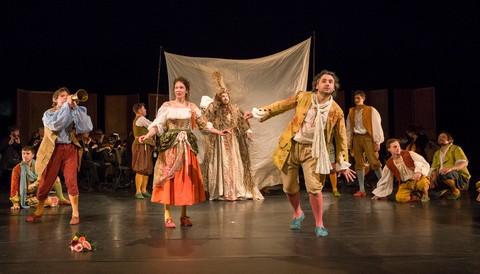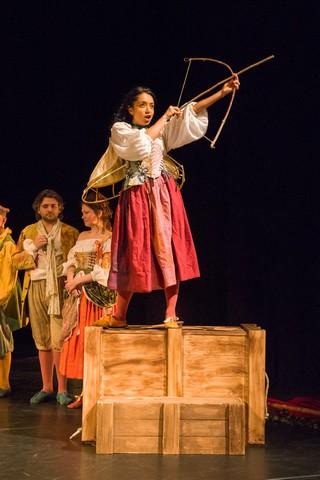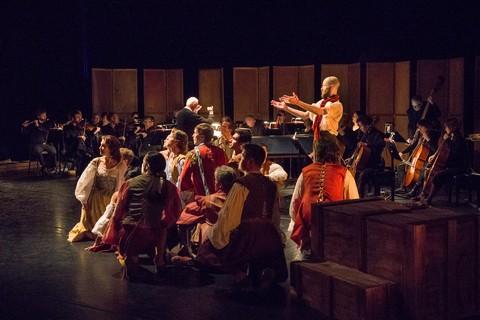Rameau, Maître à Danser (Les Arts Florissants)
An unexpectedly delightful evening of brilliant song and rather soggy dance.

Élodie Fonnard and Reinoud Van Mechelen in a scene from Les Arts Florissants’ “Daphnis et Ẻglé,” part of “Rameau, Maître à Danser” (Photo credit: Richard Termine)
[avatar user=”Joel Benjamin” size=”96″ align=”left” ] Joel Benjamin, Critic[/avatar]Les Arts Florissants, the ensemble of singers and instrumentalists specializing in the performance of baroque music on period instruments, just finished a unjustifiably short season at the BAM Howard Gilman Opera House presenting Rameau, Maître à Danser, two unrelated short dance/operas—“actes de ballet”—that music director William Christie precariously joined together making for an unexpectedly delightful evening of brilliant song and rather soggy dance.
Unlike the company’s 2016 luxuriously staged Les Fêtes Vénitiennes, also at the Gilman, Rameau was purposely staged by Sophie Daneman as if in a village square, simply but effectively, the “effects” improvised as only peasants would: entrances to temples and heaven were curtains stretched between two poles; Jupiter appeared in a high stage box as an improvised Mount Olympus; a dancer as a god glided bare-chested undetected amongst the celebrating peasantry. According to the program, this type of performance is called “théâtre de la foire” (theater of the fair).
The Les Arts Florissants orchestra and chorus were on stage behind the dramatic action, brilliantly conducted by Christie whose musicians know the Baroque style inside and out, playing the French Baroque music of Jean-Philippe Rameau (1683-1764, most popular during the reign of Louis XV).

Magali Léger in a scene from Les Arts Florissants’ “Daphnis et Ẻglé,” part of “Rameau, Maître à Danser” (Photo credit: Richard Termine)
“Daphnis et Ẻglé” told the story of the two title characters, played and sung respectively and solidly by Reinoud Van Mechelen (tenor) and Élodie Fonnard (soprano), who believe they could live as best friends until they are convinced by Amour (the lusty soprano Magali Léger) and the Grand Priest (vibrant bass, Cyril Costanzo) that they were hiding from themselves the fact that they loved each other deeply. Of course, love conquered all in song and dance.
“La Naissance d’Osiris,” the second work was linked to the first by the inclusion of a now-glowingly-pregnant Eglé and happy father-to-be Daphnis, both of whom having nothing to do with the “Osiris” scenario. (To be sure, they do produce a baby by the end of this one-act dance/opera.)
“Osiris” took place in, of all places, Thebes where the happy peasants anticipate a special event. Pamilie (Ms. Léger, still full of life) and a Berger, (a peasant played by tenor Sean Clayton, light-hearted and sweet) provide the romance. Thunder (wittily produced by a manually shaken sheet of metal) caused the Grand Priest of Jupiter (Mr. Costanzo, again in a religious role, but enjoying the difference between the two characters) to announce the appearance of Jupiter (the sexy voiced bass, François Lis, dressed in an anachronistic ultra-modern see-through long black jacket and tight black trousers) who, accompanied by Cupid and the Graces (the dancers) announced the birth of Osiris (dancer Romain Arreghini, bare-chested, his upper body oiled to perfection, dressed in diaphanous white) who wanders regally about the village. Cupid stimulates some romantic couplings, Jupiter ascended back to the heavens (the stage box) and all ended in joyful celebration.

The cast of “La Naissance d’Osiris,” part of Les Arts Florissants’ “Rameau, Maître à Danser” (Photo credit: Richard Termine)
Even given the premise that these actes de ballet were supposedly staged by local peasants, the music and singing was on a far more sophisticated level than the choreography staged by the late Françoise Denieau (to whom these performances were dedicated). Even considering the restrictions of period style, the dance stylings were unsophisticated and repetitive, although performed with great humor and panache by Mr. Arreghini, Bruno Benne, Andrea Miltnerova, Artur Zakirov, Robert Le Nuz and Anne-Sophie Berring. (The choreography was restaged by Gilles Poirier.)
The clever, layered and colorful period-ish costumes were by Alain Blanchot who also effectively used masks. Blanchot thought nothing of injecting twentieth-century style into the stage picture which sparkled under the wonderful lighting of Christophe Naillet who also proffered the simple, but effective set pieces.
A rapt, sold-out crowd was evidence of Les Arts Florissants’ deserved popularity. Maestro Christie and his creative and interpretive staff have kept the arts of the Baroque, particularly the French Baroque alive and fascinating.
Rameau, Maître à Danser (Les Arts Florissants) (March 1-3, 2019)
BAM Howard Gilman Opera House, 30 Lafayette Avenue, in Brooklyn
For tickets, call 718-636-4100 or visit http://www.BAM.org
Running time: one hour and 55 minutes including one intermission






Leave a comment